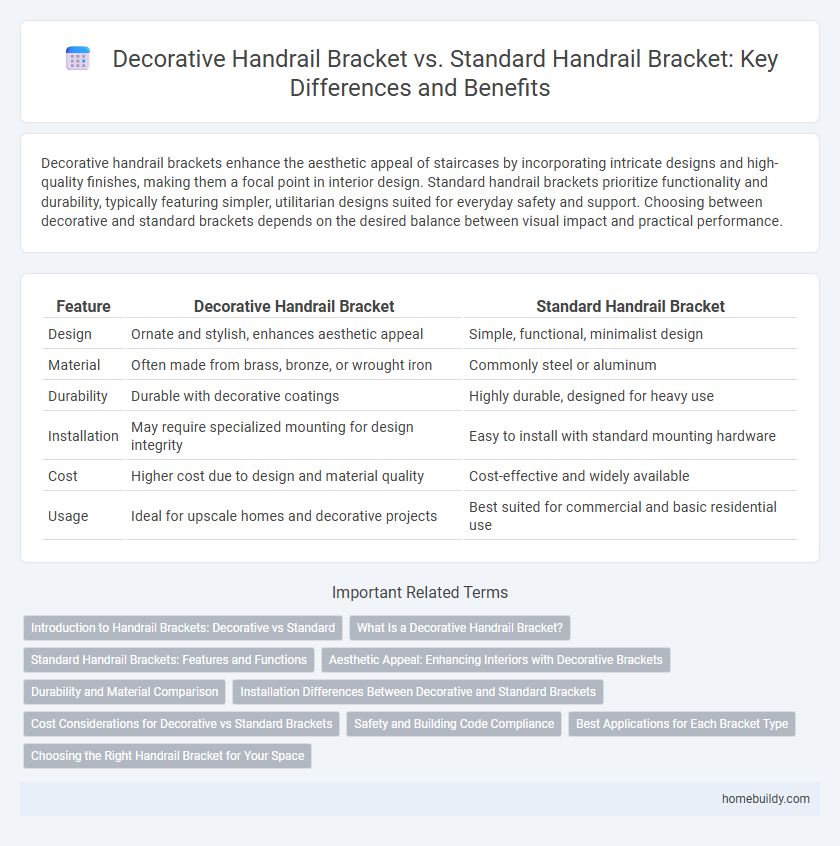Decorative handrail brackets enhance the aesthetic appeal of staircases by incorporating intricate designs and high-quality finishes, making them a focal point in interior design. Standard handrail brackets prioritize functionality and durability, typically featuring simpler, utilitarian designs suited for everyday safety and support. Choosing between decorative and standard brackets depends on the desired balance between visual impact and practical performance.
Table of Comparison
| Feature | Decorative Handrail Bracket | Standard Handrail Bracket |
|---|---|---|
| Design | Ornate and stylish, enhances aesthetic appeal | Simple, functional, minimalist design |
| Material | Often made from brass, bronze, or wrought iron | Commonly steel or aluminum |
| Durability | Durable with decorative coatings | Highly durable, designed for heavy use |
| Installation | May require specialized mounting for design integrity | Easy to install with standard mounting hardware |
| Cost | Higher cost due to design and material quality | Cost-effective and widely available |
| Usage | Ideal for upscale homes and decorative projects | Best suited for commercial and basic residential use |
Introduction to Handrail Brackets: Decorative vs Standard
Decorative handrail brackets feature intricate designs and premium materials that enhance the aesthetic appeal of staircases, making them ideal for upscale residential and commercial spaces. Standard handrail brackets prioritize functionality and durability, often crafted from basic metals with simple shapes to provide reliable support at a lower cost. Selecting between decorative and standard brackets depends on balancing design preferences with budget and structural requirements.
What Is a Decorative Handrail Bracket?
A decorative handrail bracket is designed to provide both support and aesthetic appeal, featuring intricate patterns, stylish materials, or unique finishes that enhance the overall look of staircases or railings. Unlike standard handrail brackets, which prioritize functionality with simple, utilitarian designs, decorative brackets serve as eye-catching elements that complement interior decor. These brackets are often crafted from materials such as wrought iron, brass, or custom wood, offering a blend of durability and artistic expression.
Standard Handrail Brackets: Features and Functions
Standard handrail brackets are designed primarily for functionality, offering sturdy support and secure attachment to walls or balustrades, typically made from durable metals like stainless steel or aluminum. These brackets provide essential safety by maintaining handrail stability, featuring simple designs that prioritize load-bearing capacity and ease of installation. Common in commercial and residential settings, standard handrail brackets meet building codes and safety standards without elaborate decorative elements, ensuring reliable performance.
Aesthetic Appeal: Enhancing Interiors with Decorative Brackets
Decorative handrail brackets significantly elevate the aesthetic appeal of interior spaces by incorporating intricate designs and high-quality finishes that complement various architectural styles. Unlike standard handrail brackets, which prioritize functionality and simplicity, decorative brackets serve as focal points that enhance visual harmony and sophistication. Selecting decorative brackets crafted from materials such as wrought iron, brass, or polished stainless steel transforms stairways into elegant, cohesive design elements.
Durability and Material Comparison
Decorative handrail brackets often feature materials like wrought iron or stainless steel with powder-coated finishes, providing enhanced corrosion resistance and durability compared to standard steel or plastic brackets. Standard handrail brackets, typically made from basic steel or aluminum, may be more prone to rust and wear over time, especially in outdoor or high-traffic environments. The use of high-grade alloys and protective coatings in decorative brackets extends their lifespan and maintains aesthetic appeal under harsh conditions.
Installation Differences Between Decorative and Standard Brackets
Decorative handrail brackets often require more precise alignment and additional mounting points to securely support the intricate designs compared to standard handrail brackets, which typically utilize straightforward installation with minimal hardware. The complexity of decorative brackets may involve specialized tools or anchors to ensure stability on varying wall materials, whereas standard brackets usually fit standard studs or anchors with basic screws. Proper measurement and handling are crucial for decorative brackets to maintain aesthetic appeal and structural integrity during installation.
Cost Considerations for Decorative vs Standard Brackets
Decorative handrail brackets typically cost 20-50% more than standard brackets due to intricate designs and premium materials like brass or wrought iron. Standard brackets, often made from steel or aluminum, provide functionality at a lower price point, averaging $5 to $15 per bracket compared to $15 to $40 for decorative options. Budget planning should account for both aesthetics and long-term value, as decorative brackets can enhance property appeal but require higher initial investment.
Safety and Building Code Compliance
Decorative handrail brackets enhance aesthetic appeal while maintaining structural integrity, meeting strict building code requirements for load-bearing capacity and secure attachment. Standard handrail brackets prioritize functionality and compliance, ensuring reliable support and safety in various environments without ornamental features. Both types must adhere to local safety regulations, including height, spacing, and material standards, to guarantee user protection and prevent accidents.
Best Applications for Each Bracket Type
Decorative handrail brackets are ideal for enhancing the aesthetic appeal of interior spaces such as residential staircases, boutique hotels, and upscale restaurants, combining functionality with ornamental design. Standard handrail brackets provide reliable support and durability, making them best suited for high-traffic areas like commercial buildings, schools, and public facilities where safety and compliance with building codes are paramount. Choosing between these types depends on prioritizing either visual impact or structural performance in the intended environment.
Choosing the Right Handrail Bracket for Your Space
Decorative handrail brackets enhance the aesthetic appeal of staircases with intricate designs, while standard handrail brackets prioritize functionality and durability, often featuring simpler, more utilitarian styles. When choosing the right handrail bracket for your space, consider the balance between visual impact and structural support to ensure safety without compromising design. Materials like brass or stainless steel provide long-lasting strength and style, making them suitable for both decorative and standard options.
decorative handrail bracket vs standard handrail bracket Infographic

 homebuildy.com
homebuildy.com